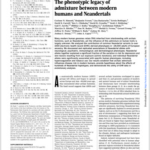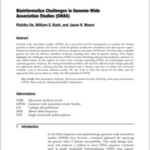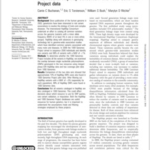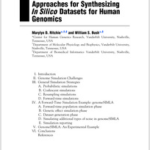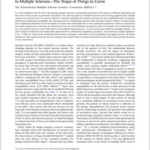Many modern human genomes retain DNA inherited from interbreeding with archaic hominins, such as Neandertals, yet the influence of this admixture on human traits is largely unknown. We analyzed the contribution of common Neandertal variants to over 1000 electronic health record (EHR)-derived phenotypes in 28,000 adults of European ancestry. We discovered and replicated associations of […]
Tag Archives: Genome, Human
The phenotypic legacy of admixture between modern humans and Neandertals.
Simonti CN, Vernot B, Bastarache L, Bottinger E, Carrell DS, Chisholm RL, Crosslin DR, Hebbring SJ, Jarvik GP, Kullo IJ, Li R, Pathak J, Ritchie MD, Roden DM, Verma SS, Tromp G, Prato JD, Bush WS, Akey JM, Denny JC, Capra JA,. Many modern human genomes retain DNA inherited from interbreeding with archaic hominins, such […]
Bioinformatics challenges in genome-wide association studies (GWAS).
Genome-wide association studies (GWAS) are a powerful tool for investigators to examine the human genome to detect genetic risk factors, reveal the genetic architecture of diseases and open up new opportunities for treatment and prevention. However, despite its successes, GWAS have not been able to identify genetic loci that are effective classifiers of disease, limiting […]
Bioinformatics challenges in genome-wide association studies (GWAS).
De R, Bush WS, Moore JH,. Genome-wide association studies (GWAS) are a powerful tool for investigators to examine the human genome to detect genetic risk factors, reveal the genetic architecture of diseases and open up new opportunities for treatment and prevention. However, despite its successes, GWAS have not been able to identify genetic loci that […]
A comparison of cataloged variation between International HapMap Consortium and 1000 Genomes Project data.
Since publication of the human genome in 2003, geneticists have been interested in risk variant associations to resolve the etiology of traits and complex diseases. The International HapMap Consortium undertook an effort to catalog all common variation across the genome (variants with a minor allele frequency (MAF) of at least 5% in one or more […]
A comparison of cataloged variation between International HapMap Consortium and 1000 Genomes Project data.
Buchanan CC, Torstenson ES, Bush WS, Ritchie MD,. Since publication of the human genome in 2003, geneticists have been interested in risk variant associations to resolve the etiology of traits and complex diseases. The International HapMap Consortium undertook an effort to catalog all common variation across the genome (variants with a minor allele frequency (MAF) […]
Genome simulation approaches for synthesizing in silico datasets for human genomics.
Simulated data is a necessary first step in the evaluation of new analytic methods because in simulated data the true effects are known. To successfully develop novel statistical and computational methods for genetic analysis, it is vital to simulate datasets consisting of single nucleotide polymorphisms (SNPs) spread throughout the genome at a density similar to […]
Genome simulation approaches for synthesizing in silico datasets for human genomics.
Ritchie MD, Bush WS,. Simulated data is a necessary first step in the evaluation of new analytic methods because in simulated data the true effects are known. To successfully develop novel statistical and computational methods for genetic analysis, it is vital to simulate datasets consisting of single nucleotide polymorphisms (SNPs) spread throughout the genome at […]
Evidence for polygenic susceptibility to multiple sclerosis–the shape of things to come.
It is well established that the risk of developing multiple sclerosis is substantially increased in the relatives of affected individuals and that most of this increase is genetically determined. The observed pattern of familial recurrence risk has long suggested that multiple variants are involved, but it has proven difficult to identify individual risk variants and […]
Evidence for polygenic susceptibility to multiple sclerosis–the shape of things to come.
, Bush WS, Sawcer SJ, de Jager PL, Oksenberg JR, McCauley JL, Pericak-Vance MA, Haines JL,. It is well established that the risk of developing multiple sclerosis is substantially increased in the relatives of affected individuals and that most of this increase is genetically determined. The observed pattern of familial recurrence risk has long suggested […]
Mind the gap: resources required to receive, process and interpret research-returned whole genome data.
Most genotype-phenotype studies have historically lacked population diversity, impacting the generalizability of findings and thereby limiting the ability to equitably implement precision medicine. This well-documented problem has generated much interest in the ascertainment of new cohorts with an emphasis on multiple dimensions of diversity, including race/ethnicity, gender, age, socioeconomic status, disability, and geography. The most […]
Mind the gap: resources required to receive, process and interpret research-returned whole genome data.
Most genotype-phenotype studies have historically lacked population diversity, impacting the generalizability of findings and thereby limiting the ability to equitably implement precision medicine. This well-documented problem has generated much interest in the ascertainment of new cohorts with an emphasis on multiple dimensions of diversity, including race/ethnicity, gender, age, socioeconomic status, disability, and geography. The most […]


